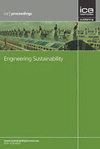基于离心试验的预制挡土墙系统性能评估
IF 1.5
4区 工程技术
Q3 ENGINEERING, CIVIL
Proceedings of the Institution of Civil Engineers-Engineering Sustainability
Pub Date : 2024-02-14
DOI:10.1680/jensu.23.00072
引用次数: 0
摘要
预制和装配式挡土墙系统正逐渐成为边坡加固和土方保持结构的首选。然而,由于生产尺寸不一致和运输困难等问题,目前的预制挡土墙系统往往难以应用于复杂多变的施工现场。本文介绍了一种新型预制挡土墙系统,并报告了为分析其整体性能而进行的离心机模型试验。研究了不同填充材料对预制挡土墙系统性能的影响。研究结果表明,挡土墙系统具有显著的斜坡稳定效果,可承受高达天然斜坡四倍的应力水平。此外,与使用粘土填充物相比,用摩擦土填充挡土墙系统的稳定性要好两倍以上。由于其独特的结构,它不仅能减少约 63.94% 的材料消耗和二氧化碳排放,还能在构件间隙种植绿色植物,从而为传统的混凝土重力墙系统提供了一个更具可持续性的替代方案。本文章由计算机程序翻译,如有差异,请以英文原文为准。
Performance evaluation of prefabricated retaining wall systems based on centrifuge tests
Prefabricated and assembled retaining wall systems are gradually becoming the choice for slope stabilisation and earth-retaining structures. However, current prefabricated retaining wall systems are often difficult to apply in complex and variable construction sites due to issues such as inconsistent production dimensions and transportation difficulties. This paper presents a novel prefabricated retaining wall system and reports centrifuge model tests performed to analyse its overall performance. The influence of different infill materials on the performance of the prefabricated retaining wall system was studied. The research findings reveal that the retaining wall system provides significant slope stabilisation effects and can withstand up to four times the stress level of a natural slope. Moreover, the stability of the retaining wall system is more than twice better when infilled with frictional soil compared with that when clay infill is used. Due to its unique structure, it can not only reduce material consumption and carbon dioxide emissions by around 63.94% but also allow planting of green plants in the gaps of components, thereby providing a more sustainable alternative to conventional concrete gravity wall systems.
求助全文
通过发布文献求助,成功后即可免费获取论文全文。
去求助
来源期刊

Proceedings of the Institution of Civil Engineers-Engineering Sustainability
ENGINEERING, CIVIL-ENGINEERING, CIVIL
CiteScore
3.70
自引率
16.70%
发文量
44
审稿时长
>12 weeks
期刊介绍:
Engineering Sustainability provides a forum for sharing the latest thinking from research and practice, and increasingly is presenting the ''how to'' of engineering a resilient future. The journal features refereed papers and shorter articles relating to the pursuit and implementation of sustainability principles through engineering planning, design and application. The tensions between and integration of social, economic and environmental considerations within such schemes are of particular relevance. Methodologies for assessing sustainability, policy issues, education and corporate responsibility will also be included. The aims will be met primarily by providing papers and briefing notes (including case histories and best practice guidance) of use to decision-makers, practitioners, researchers and students.
 求助内容:
求助内容: 应助结果提醒方式:
应助结果提醒方式:


